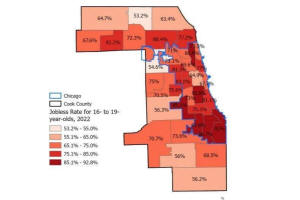|
Lead researcher Matt Wilson said Black teens in Chicago have
been disconnected from work and school at twice the rate they
were in 2021.
“So we have this huge jump where there’s an additional over
16,000 Black 16-to-19-year-olds that are not working and not in
school,” Wilson said.
The report indicated that not all communities have recovered
from pandemic-related shutdowns at the same rate. The Chicago
Public Schools system returned to in-person learning much later
than other schools in the area.
“Those individuals … the probability of them seeping through the
cracks is going to be very high,” Wilson said.
Jack Wuest, executive director of the Alternative Schools
Network, said the state of Illinois should spend $300 million to
address youth joblessness, instead of spending on other projects
like transit or sports stadiums.
“It’s a question of priorities, obviously,” Wuest said. “It’s
basically a hedge against the kids doing things out in the
neighborhoods.”
The Alternative Schools Network commissioned the report by the
University of Illinois-Chicago’s Great Cities Institute, which
found that, across the state, more than 163,000
16-to-24-year-olds are not working or in school.
Wilson said if Illinois spent $300 million on youth employment,
the benefits would reduce crime and probably pay out 11-to-1.
“It’s expensive, but it’s a smart investment. It’s an investment
that pays for itself in the end,” Wilson said.
Wuest said it’s inexcusable that President Joe Biden has not
addressed youth joblessness at the national level.
“It’s important, maybe that he puts $97 billion for Ukraine and
Israel. Put $6 billion dollars and get the kids who are in our
neighborhoods to work,” Wuest said.

|
|





